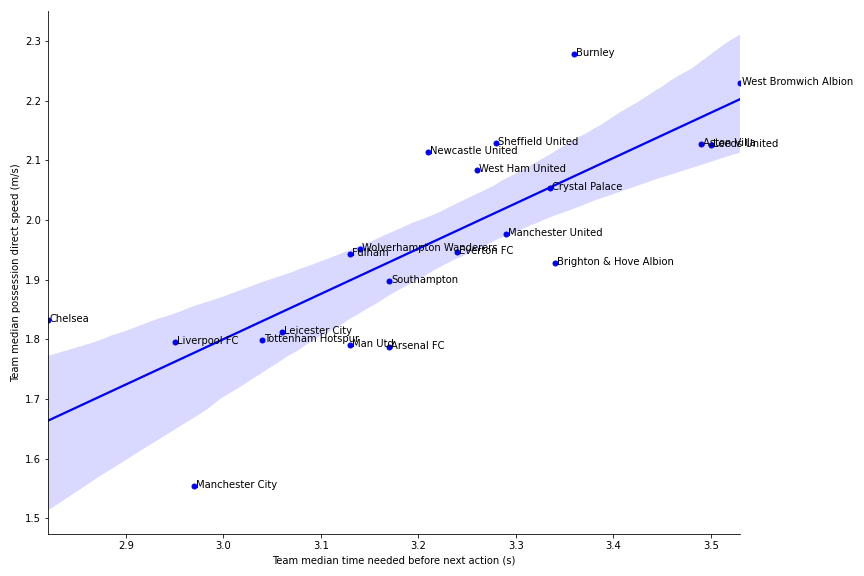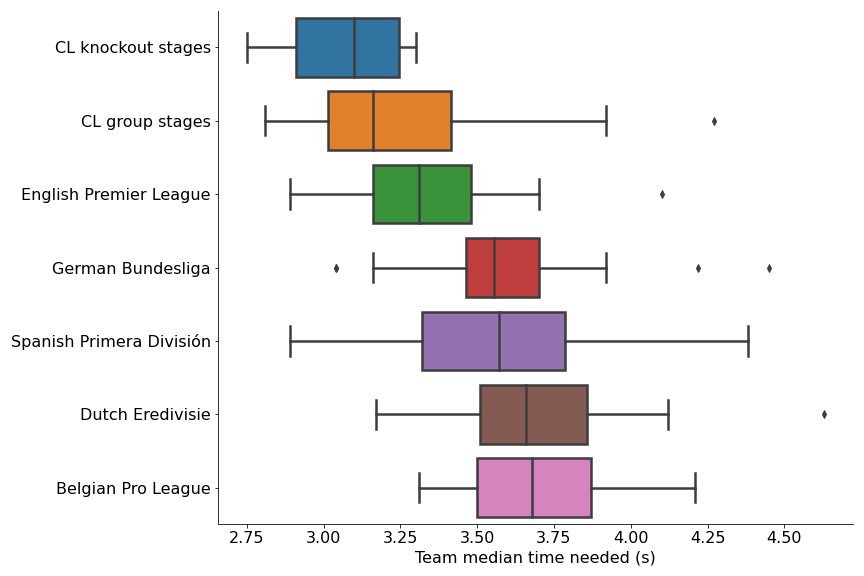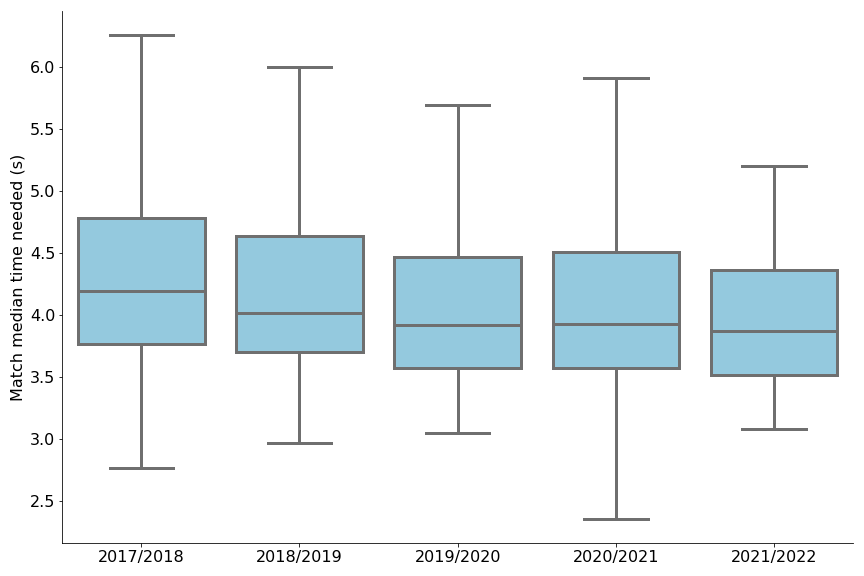An essential part of offensive play in soccer is the ability to move the ball quickly around to create space in the opponent’s defense. To keep the pace up, players need to quickly move the ball after receiving it, which requires three important skills. Firstly, players need the technical ability to execute the reception and next movement action both quickly (i.e., using little time) and accurately (i.e., passing with the right speed at the right foot of a teammate). Secondly, cognitive skills are essential as players must be able to make quick decisions and keep an overview of where teammates and opponents are. Thirdly, players need the physical ability to control the ball, maintain their balance, and quickly move their feet to perform the next action.
“Nobody is faster than the ball, not even the fastest player and we have to move the ball quicker — we train every day for that”
— Pep Guardiola
The intensity of the game, identified by the speed in which the ball is moved around and distance it travels, differs across leagues and teams. The higher the level, the faster that players need to be able to think and react to move the ball in a good way. Therefore, it is essential for recruitment purposes to find players that can match the intensity of their new team. Players might excel in a lower-level league where they have slightly more time on the ball, but their performance might not carry over to a new league where the pace is higher and they are afforded less time.
This blogpost introduces a simple Pace Metric that captures the intensity of play using ball event data. Using our Pace Metric we analyze differences across leagues, teams and players in different areas of the pitch. According to our Pace Metric, Champions League matches (from group stages onwards) have the highest pace in both the women’s and men’s game. We also touch upon the variation in pace level between teams in a league, which is smaller in the men’s English Premier League compared to the men’s Spanish Primera División. We also observe that pace has increased over time in the women’s game which is remarkably combined with a higher pass success rate. Furthermore, we show how the metric could be used to identify interesting young players that show a high pace compared to the other players in their team or league. 22-year-old Donny van de Beek showed a high pace at Ajax in the Dutch Eredivisie and 22-year-old Nerea Eizaguirre currently plays at a high pace at Real Sociedad in the women’s Spanish Primera División Femenino.
Pace Metric
We use ball event data provided by SciSports in SPADL format enriched with SciSports’ features such as VAEP ratings, the scoreline, deep completions, possessions and more. We want to capture the time used by a player between receiving the ball and moving the ball to another teammate again. For this, we exclude actions that do not move the ball from one player to the other such as ball carries and take-ons. Next, we collect all passes, crosses and shots that do not directly follow a change in possession and are thus preceded by a pass or cross from a teammate. The Pace Metric (PM) is then computed as follows:
Where is the start time of action , which is the moment the ball leaves the foot. This measure serves as a proxy for the time needed to control the ball, to decide where to go next and to execute the next action.
Our metric is limited in the sense that it ignores the time needed for the ball to travel the distance to the receiver, which could be solved by tracking data or timestamps on receiving. Figure 1 shows that there is indeed a slight correlation between the percentage of balls received from long distance (at least 34 meters) and our Pace Metric.

Pace and intensity has been studied by others as well. In 2012, The Executioner’s Bong used Prozone’s passing tempo to analyze Everton’s passing style, where passing tempo is defined as a team’s ‘time on the ball divided passes made’. Soccermetrics published several blog posts on match tempo back in 2013, where match tempo is defined as ‘distance that the ball travels in a possession over the possession’s duration’. The same year StatsBomb’s Ted Knutson used the total number of shots to determine the pace of play in a game. Kevin Minkus used the total passes attempted per game to analyze the pace of play in the MLS. Stats Perform introduced their Direct Speed Metric used to analyze team possession sequences. This Direct Speed Metric looks at the speed at which the ball moves in the x-direction in a possession sequence. We observe a slight positive correlation between the Direct Speed Metric and our Pace Metric. Figure 2 shows that teams that need more time on the ball are also more likely to be more direct-playing teams, which favor long balls over short passes. Although both Chelsea’s and Manchester City’s players have a high pace on the ball, both teams differ in their directness of play.

The value of our Pace Metric is that, unlike those other metrics, we can analyze pace on a player-level which is extremely useful for recruitment purposes.
League intensity
Assigning one value to a league is hard. Is it characterized by the best team, the worst team or the most typical team in the league? We analyze the distribution of the team pace over leagues to identify the differences between them, resulting in insights on the most intense league overall and leagues with more variety in the pace across their teams.
Champions League intensity
Figure 3, shows the team pace distributions for teams in the men’s game. We observe the highest pace amongst the Champions League teams, especially in the knockout stages. The English Premier League is the highest-paced domestic league, with most teams playing at a higher pace than Bundesliga and Primera División teams. The Dutch Eredivisie and Belgian Pro League are comparable with the pace lagging behind the bigger leagues.

Figure 4, shows the team pace distributions for teams in the women’s game. Again, we observe the highest pace in the Champions League. Furthermore, we observe more widespread differences between the teams in those leagues.

Women’s soccer increased pace
Figure 5 shows the evolution of time needed on the ball in matches played in the European top leagues: the English WSL, the German Frauen Bundesliga, the French Ligue 1 and the Spanish Primera Division. We observe that over time the pace of the game has increased and players need less time on the ball. An interesting observation is that players play at a higher pace and spend less time on the ball, but their pass accuracy has also increased over time from 75.1% before 2020 to 76.4% since 2020. This is an indicator of the recent developments in the women’s game now that more and more players are able to play on a professional level.

Player intensity
As we are especially interested in the maximal intensity that players are capable of playing at, we do not care about the phases played at low intensity. These irrelevant phases could occur when the team is leading and wants to slow down the intensity of the game or when there are no good options available and the player keeps the ball to lure the opponent into exerting pressure. As such phases might be hard to identify and we can never look into the heads of the players, we choose to analyze the median pace on the ball in the final third of the pitch.
One-touch Donny
Donny van de Beek played great 2018/2019 and 2019/2020 seasons with Ajax both in the Dutch Eredivisie and the Champions League, earning him a transfer to Manchester United. In these seasons, he was Ajax’ player with the littlest time needed on the ball in the opponent’s half in their Champions League and Eredivisie matches. Figure 6 shows that he played especially at a high pace in the areas close to the opponent’s box, where he often needed less than 2 seconds (25% percentile of time needed per action in our dataset) to move the ball again. Despite showing the ability to operate at a high pace comparable to those of a top Premier League team, while at Ajax, he was never able to earn regular minutes at Manchester United. This winter van de Beek was loaned out to Everton and his first games were promising. Let’s hope he can show his qualities in moving the ball at a fast pace the rest of this season.
Spanish tiki-taka
Well-known players like Alexia Putellas, Eugenie Le Sommer, Pernille Harder, Amel Majri, Aitana Bonmati and Jennifer Hermoso top the final third Pace Metric list in the women’s game. Amongst those players playing for top sides in Europe we find a young talent playing at a high pace: Real Sociedad’s Nerea Eizaguirre. Real Sociedad, currently ranked second in the Primera División, moves the ball around at a high pace, and 22-year-old Eizaguirre plays an important role in their speed of play. Figure 7, shows that she especially shows high pace (fewer than 2 seconds on the ball) on the midfield.
Conclusion
We introduced our Pace Metric that measures the time that a player needs on the ball before moving the ball again towards a teammate or the goal. We showed the differences between leagues and their teams, and identified Donny van de Beek and Nerea Eizaguirre as players that show a higher pace than their teammates not at Europe’s top sides. We also showed the increase in pace and pass accuracy in the women’s game. We will devote our next blog post to more insights on the recent developments in the women’s game.